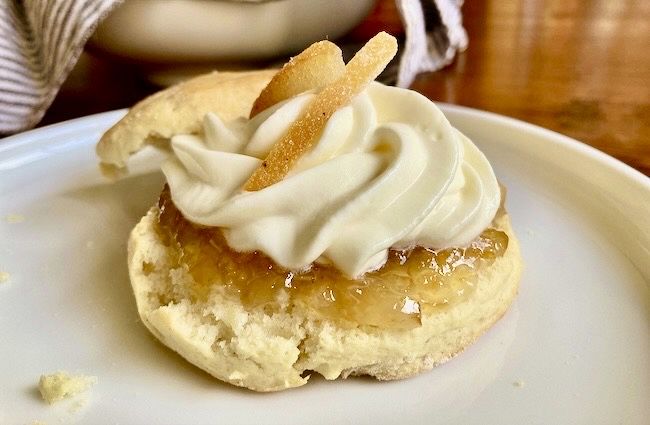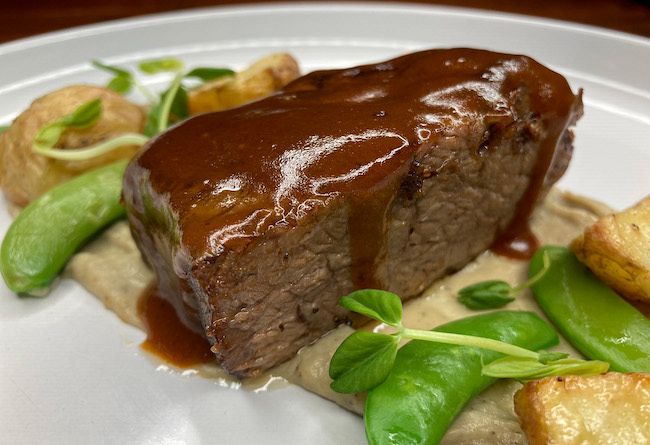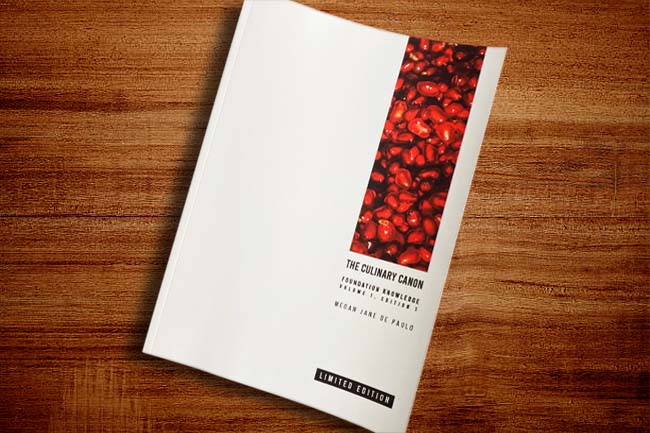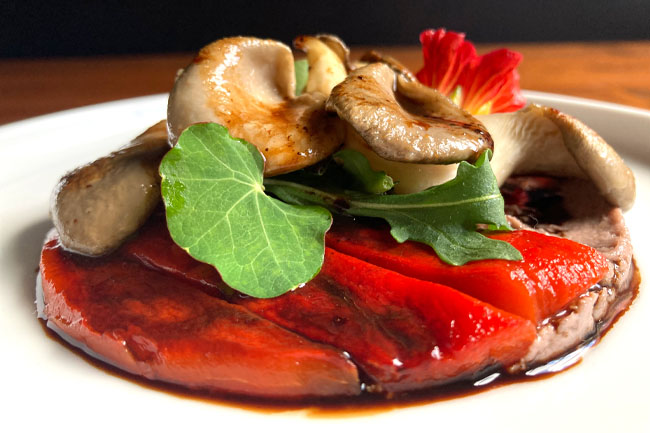Megan Jane de Paulo rolls out her tribute to the humble scone — a tea-time accompaniment firmly 'en-scon-ced' in our culinary history. Cuppa, anyone?
IT HAS NO yeast, so it is not bread. Not a cake. Nor a biscuit. Not pastry — but most closely related to it.
It is the humble scone.
A nostalgic baked nibble, snack sized, usually slathered with jam and cream... in my case, shoved into one hand, with a tepid Milo in the other, upon being sent away to play while adults chat over cups of tea.
An assemblage of crumbs coaxed together with care, flour, milk and cream/butter, and some baking powder for lightness and rise. This time-tested recipe can be created with a series of modifications and perversions for fun along the way, skirting the boundaries of sweet and savoury at the whim of the baker.
The definitive origin of the scone remains in some dispute, but it seems to have derived from the Scottish bannock or the Dutch schoonbrood. The Oxford English Dictionary records its first mention in English literature from 1513.
The addition of scones to "High Tea" was initiated in 1840 by Anna Russell, the Duchess of Bedford, where it was served with jam and clotted cream — although the working class break-time from where the concept of High Tea is derived probably almost certainly served scones.
Do you say scone (as in “gone”) or scone (as in “tone”)? It seems to be more regional than class-based; the majority of people rhyme scone with gone. Astonishingly Australians have never managed to create a diminutive or nickname for scones — there are no sconnos to have at smoko, or jammy rocks. We actually stick to its correct name.
Shoved aside by upstart break-time snacks such as the muffin, cruffin and excessively accessorised doughnut, scones have rolled back into focus recently with a resurgence of a long-term unresolvable controversy over whether the jam or cream goes on first.
This has been investigated at some length, with the result being some people like the jam first and some the cream, and they will argue about this until the end of time. This disagreement stems from a difference between Cornwall and Devon: two regions in the UK barely 140 kilometres apart — a distance which wouldn’t even take you out of Victoria if your starting point was Melbourne.

Cornwall has declared the jam is spread first and the cream added on top; Devon that, since the cream is a substituted form of butter, it must go first, then be topped with jam.
In Australia, jam first is more popular – likely due to the absence of clotted cream used in the UK – with whipped Chantilly cream (more common, being less dense and viscous than jam) placed on top.
The biggest scone crime committed is believed to be the American version, which they call “biscuits” to further confuse baked goods enthusiasts across the world. They serve their “biscuits” with a sausage gravy that’s a bastardised version of the French béchamel sauce, this one loaded with sausage and bacon grease until it takes on a slightly grey pallor. "Biscuits" are usually served at breakfast.
American "biscuits" are mostly made with buttermilk and rarely served with jam, although further north across the border, Canadians wrestling with their region and historical UK ties apparently eat them with gravy or jam — rumour reveals that sometimes it's both!
One of the most famous scones is the "Scone of Stone" featured in Sir Terry Pratchett’s Discworld series — not to be confused with the Stone of Scone: the relic that made an appearance at the recent coronation of King Charles.
While a quiche was the focus of Coronation fare, scones also unsurprisingly made an appearance, being a UK staple (although the inclusion of tacos will remain forever baffling). You can find the Official Coronation recipe here. But you're in for a royal treat if you choose to bake Nanna’s scones, as seen below!
RECIPE
Based on a Country Women’s Association recipe and adapted to a smaller batch size, these scones are best eaten warm straight out of the oven: they only keep for 1-2 days before drying out.
Quick to mix up and cut out (baking in 15-20 minutes), these scones don't require any resting, kneading or proofing. You can use a metal cutter to create circular scones — my nanna used an old Vegemite glass for hers. You can also pat into a rectangle and cut squares or use a disc and cut across to make wedges.
Nanna’s Scones
- 250g of self-raising flour
- 150ml whole milk
- 150ml cream (not light)
- salt, pinch
Instructions
- Preheat oven to 200ºC.
- Line a baking tray with paper.
- Sift flour and salt into bowl.
- Add milk and cream.
- Using a butter knife, mix until the ingredients come together into a rough dough.
- Dump the dough onto a lightly floured surface — do not knead, but pat out gently to a depth of about 2 cm.
- With a round cutter, stamp out circles. Do not twist the cutter while doing so. You can bring together the remnants and cut more out until all dough is used.
- Place rounds of dough on a tray. Brush tops sparingly with milk.
- Bake until golden and serve when warm.
Notes
Such a simple recipe shouldn’t have so many detailed notes, but it’s a tightrope walk: one misstep and you fall foul of the classic light scone, finishing with a dense rock.
Sifting flour
Using weight means you get the right amount each time, regardless of whether sifted or not. But when using mass, sifting can have a huge difference in the end measurement. A cup of sifted flour will weigh much less than a compacted unsifted cup.
Sifting also removes any unpleasant lumps or mystery additions lurking in the flour. Most flour in Australia has already been triple-sifted, so you can skip this if you are confident in your flour storage and use of a kitchen scale to measure rather than using cups.
Sifting aerates flour but doesn’t necessarily make your baked goods fluffier.
Mixing
A butter knife brings together the dry and liquid ingredients without exciting the gluten too much and risking toughness.
No kneading
In the case of scones kneading will result in a tough rock, so avoid handling as much as possible.
No twisting when cutting
You want a "stamping out action". Twisting the cutter (whether a biscuit cutter or glass) seals the edges, impeding the rise of the scone. Twisting = flat rock.
Adding ingredients
You might need to add extra flour or milk, depending on what you add in.
Common additions
- dried fruit such as raisins, dates or figs (Presoaking may be necessary: for a kick, presoak in rum.)
- spices
- fresh herbs such as chives are popular
- cheese
- pumpkin mash (you will need extra flour)
- cocoa and chocolate chips
Various recipes
Some recipes substitute lemonade or ginger beer for milk for extra rise; some use butter instead of cream and buttermilk or yoghurt for the dairy. The above recipe is closest to a traditional scone recipe. With acidic additions such as buttermilk, you might need to add some baking soda for a better rise.
Megan Jane de Paulo is a Melbourne-based, inner-city latte sipper and social media provocateur. You can follow Megan on Twitter @gomichild.
Related Articles
- Fleur de Sel Salted Caramels: Because life's too short not to
- Mastering 100+ recipes: Easier than it sounds
- Pumpkin tortillas: Using leftover food wisely
- Cooking with miso: Flavour for days
- How to adapt rich recipes for reuse and reinvention
 This work is licensed under a Creative Commons Attribution-NonCommercial-NoDerivs 3.0 Australia License
This work is licensed under a Creative Commons Attribution-NonCommercial-NoDerivs 3.0 Australia License
Support independent journalism Subscribe to IA.













